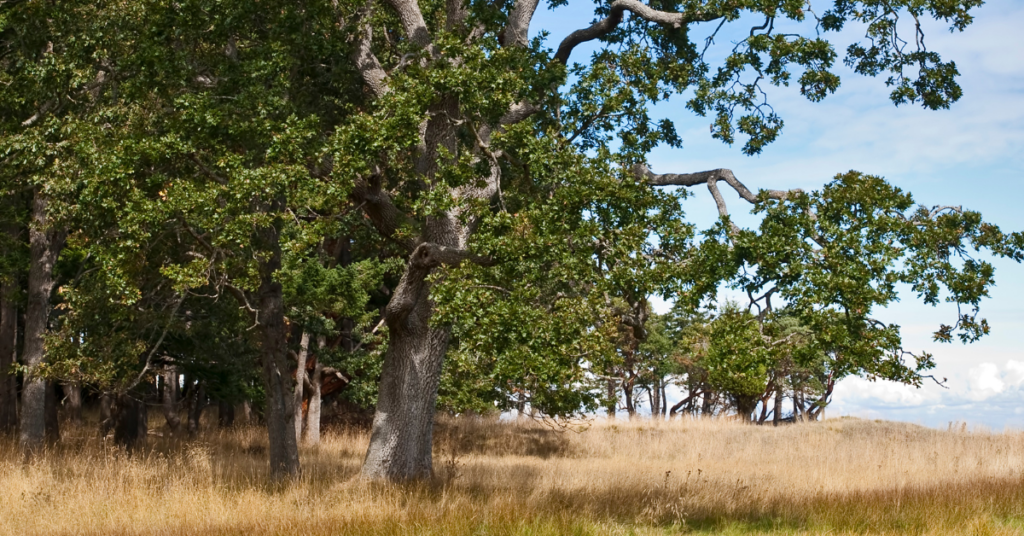1. Choose Drought-Resistant Trees
Selecting the right species is the first step towards ensuring tree health during droughts. Opt for native or drought-resistant trees that are well-adapted to Victoria’s climate. Species such as Garry oak, Arbutus, and Douglas fir are excellent choices. These trees have evolved to thrive in local conditions and require less water than non-native species. Choosing drought-resistant trees can prevent many issues, but sometimes, removal becomes necessary. Signs it might be time to remove your tree include severe drought stress, significant deadwood, and compromised structural integrity.
2. Proper Mulching

Mulching is a crucial practice in conserving soil moisture and protecting tree roots from extreme temperatures. Apply a 2-4 inch layer of organic mulch, such as wood chips or bark, around the base of the tree. Ensure the mulch is spread evenly and avoid piling it against the trunk to prevent rot and pest issues. Proper mulching not only conserves soil moisture but also provides a stable base to help prevent storm damage to your trees, ensuring they remain upright and healthy during extreme weather.
3. Efficient Watering Techniques
Watering trees efficiently is vital during drought conditions. Deep watering is more beneficial than frequent shallow watering as it encourages deeper root growth. Water the trees early in the morning or late in the evening to minimize evaporation. Efficient watering techniques are essential, but understanding the difference between tree trimming and pruning can also enhance tree health by reducing water demand through strategic branch removal. Use drip irrigation systems or soaker hoses to deliver water directly to the root zone, ensuring optimal absorption.
4. Pruning for Health
Regular pruning helps maintain tree health by removing dead or diseased branches, improving air circulation, and reducing water demand. Regular pruning during the dormant season is key to tree health. Adhering to proper pruning practices helps remove diseased branches and improves air circulation, thus maintaining overall tree vitality. Prune during the dormant season to minimize stress on the trees. Avoid heavy pruning during drought periods as it can further stress the trees and increase their vulnerability to pests and diseases.
5. Soil Management

Healthy soil is the foundation of healthy trees. Improve soil structure and water retention by adding organic matter such as compost. Healthy soil management is crucial for tree health. Incorporating organic matter can significantly prevent diseases and pests from harming your trees by enhancing soil structure and water retention. Avoid compacting the soil around the tree roots, as compacted soil reduces water infiltration and root growth. Aerate the soil if necessary to enhance its ability to absorb and retain water.
6. Regular Monitoring and Maintenance
Consistent monitoring and maintenance are vital for detecting early signs of drought stress. For expert care and to ensure optimal tree health, hire an ISA Certified Arborist. Look for symptoms such as wilting, leaf scorch, and premature leaf drop. Address issues promptly to prevent further damage by hiring the certified arborists at Anchor Tree Service. Regularly check the irrigation system to ensure it is functioning correctly and delivering adequate water to the trees.
7. Protecting Young Trees
Young trees are more susceptible to drought stress due to their underdeveloped root systems. Provide extra care by ensuring they receive sufficient water and are protected from harsh conditions. Consider using tree shelters or shade cloths to reduce water loss and shield young trees from direct sunlight.
8. Utilizing Water-Saving Practices
Incorporate water-saving practices in your landscape to support tree health. Group plants with similar water needs together, reduce lawn areas, and replace them with drought-tolerant ground covers. Implement rainwater harvesting systems to collect and store rainwater for irrigating trees and other plants during dry periods. Utilizing water-saving practices is essential for tree health. In times of severe drought, knowing what to do when trees pose immediate risks can save both the tree and surrounding property.
Conclusion
Maintaining tree health in drought-prone areas like Victoria, BC, requires a combination of strategic planning, efficient water use, and proactive care. By selecting the right tree species, employing proper mulching and watering techniques, engaging in regular monitoring and maintenance, and hiring certified arborists at Anchor Tree Service when needed, homeowners can ensure the longevity and vitality of their trees. Embracing these practices not only enhances the beauty of individual properties but also contributes to the overall resilience and sustainability of Victoria’s urban forest.

Maintaining the health and beauty of your trees, especially in drought-prone areas like Victoria, BC, requires expert care and proactive measures. At Anchor Tree Service, we specialize in providing comprehensive tree care solutions tailored to the unique needs of our local environment. Whether you need help selecting drought-resistant species, efficient watering techniques, or professional pruning and maintenance, our certified arborists are here to assist. Don’t let your trees suffer during dry periods—reach out to us today for a consultation and ensure the longevity and vitality of your landscape. Contact Anchor Tree Service now and let us help you create a thriving, resilient urban forest right in your backyard.


